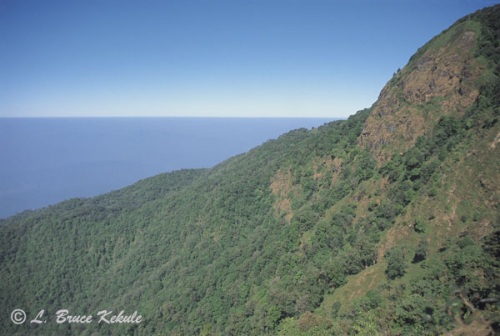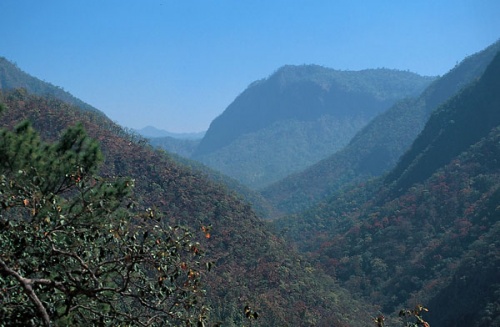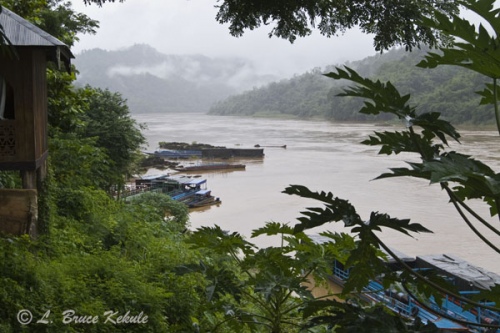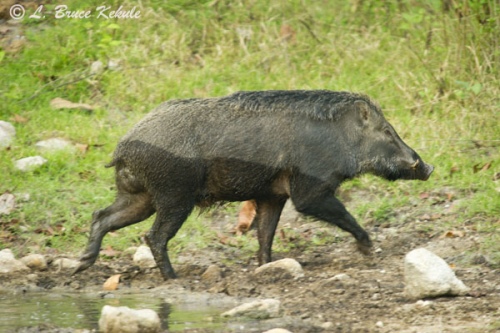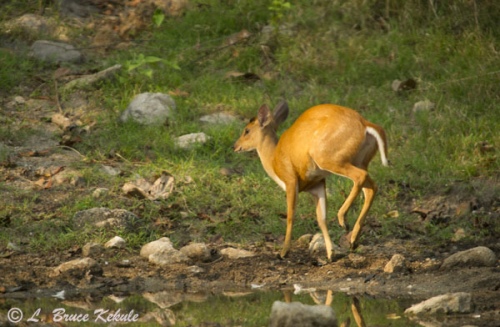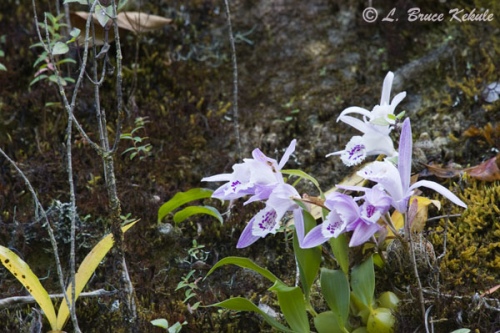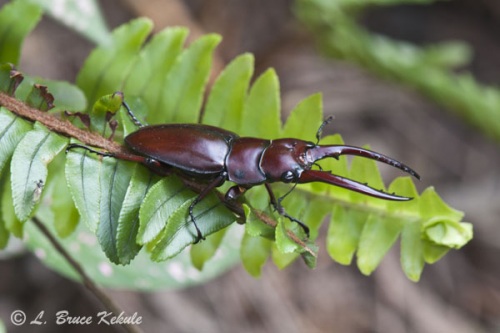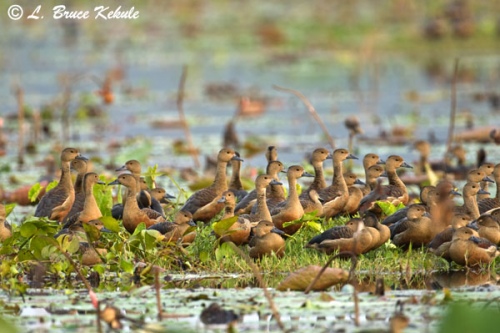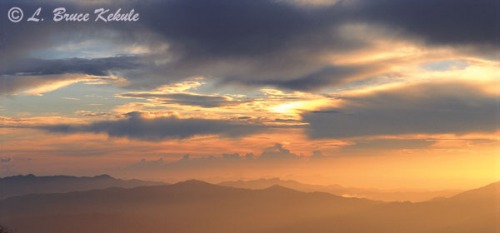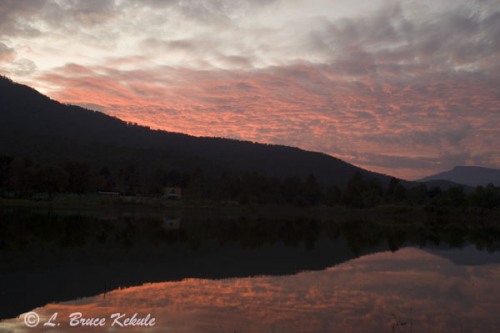Posts Tagged ‘mountains’
Mountains of the North
Majestic beauty, rugged granite massifs, fertile forests, steep terrain, thunderous waterfalls and sparkling waterways
Satellite map of Northern Thailand, Burma and Laos
Doi Inthanon National Park
Some 60 million years ago, the sub-continent India moving on tectonic plates crashed into the Asian mass that created a ripple effect across Southeast Asia, and many mountain ranges up-lifted forming over time. Most of these run from north to south creating a blanket upshot across northern Thailand plus areas in Burma and Laos.
Mountains in Mae Hong Son province
This terrain is divided into many mountains and valleys with rivers that bring life to the region and the people. The North is essentially a series of mountain ridges folded between two mighty off shoots of the Himalayan Range: The Dawa-Tenasserim in the West and the Annamite Range in the East.
Goral jumping in Mae Lao-Mae Sae Wildlife Sanctuary
The prehistoric significance of animal and plant life is a treasure trove of ancient creatures now extinct. From 80,000 to 140,000 years ago, the giant panda lived in these mountains. Fossil remains have been found in a cave in Mae Hong Sorn by palaeontologists from the Department of Resources with French counterparts. Rhino were common and many remains have come forth.
Wachiratan Waterfall in Doi Inthanon
Going back even further to 10 million years ago, ancestors of the orang-u-tang thrived here and fossil-teeth of these great apes have been uncovered in lignite mines in Phrayao district of Chiang Rai. The rainforests were thick vegetation and ecosystems had a vast array of flora and fauna.
Salaween River in Mae Hong Son province
Approximately 4,000-5,000 years ago, a small group of Hoabinhians (named by archaeologists) or ‘Stone Age’ man were hunter-gatherers, and lived in a narrow valley named Ob Luang gorge southwest of Chiang Mai. These people camped under a rocky ledge near the Mae Chaem River and left red and white cliff drawings depicting the wildlife at the time. The fragmented remains of these prehistoric paintings can still be seen today. These people used stone tools, and depended heavily on wild animals for subsidence.
Siriphum Waterfall in Doi Inthanon
During the Bronze Age, people established permanent settlements nearby, leaving behind signs of civilization using bronze tools, jewellery and pottery. With more advanced weapons, they began to decimate the wildlife and clear the forests for agriculture and a settled existence. With the advent of the Iron Age and increased populations and better weapons, hunters began to have a significant impact on the surrounding flora and fauna. Forest clearing increased as populations became bigger. Settlements along the rivers were the first to be colonized.
Wild boar in Om Koi Wildlife Sanctuary
In the old days, large carnivores like the tiger, leopard and bear were found in all these thick forests. Huge herds of gaur, banteng and elephant lived off the profuse vegetation and proliferated. These mega-fauna lived in the precipitous mountains and thrived on abundant food sources and mineral deposits for supplements. Wild flora and fauna was extremely plentiful and at one time was taken for granted.
Prancing muntjac in Om Koi Wildlife Sanctuary
Around the beginning of the twentieth century, northern Thailand’s many beautiful mountain ranges and valleys were covered with extensive natural teak and deciduous forests. Unfortunately, much of the area has since been heavily logged, cultivated and/or encroached upon.
Orchids in Doi Inthanon
Humans laid siege to the land. When logging concessions were in full swing, living off the land as the loggers penetrated deeper and deeper into virgin forest tracts literally wiped out many places before the logging ban in 1989 and prior to conservation and protection came into play. The logging companies reaped in the profits from the natural resources that had evolved over millions of years. This sad chain of events shows this destruction layed upon the land and the effects of poor watersheds with only fair water retention ability after large scale flooding downstream from the North last year.
Staghorn beetle in Doi Inthanon
At the beginning of winter during November in the north of the Kingdom is a time of beauty. The skies are normally cloudless blue and the weather is crisp and cool. Early morning fog blankets the lower valleys, and rivers and streams run crystal clear. It is at the end of the rainy season and waterfalls cascade down mountain slopes and moisture is 100 percent.
Chiang Saen Lake in Chiang Rai province
In some areas, animals like goral and serow (rare goat-antelopes) still live on rocky crags while deer, wild pigs and wild dogs flourish in steep forests. Birds, insects, reptiles and amphibians plus a huge array of plant life continue to exist. The balance of nature reigns supreme as nature intended. But these biospheres are under greater pressure as time passes on.
Whistling ducks in Chiang Saen lake
For this story, all the provinces from Tak and Uttaradit up to Chiang Mai, Lampoon, Lampang, Mae Hong Sorn, Chiang Rai, Phrae and Nan are blessed with these unique ecosystems. In Thai, ‘doi’ means mountain. The North’s original pristine beauty however now remains primarily in only a few protected areas, the most important of which are described below:
Doi Inthanon National Park
Sunset over Doi Inthanon
Doi Inthanon is Thailand’s highest mountain rising to 2,595 meters, and is part of the Thanon Thongchai Range that extends south from the Shan hills of Burma to the province of Tak. Situated southwest of Chiang Mai, this 482 square kilometre national park was gazetted in 1972 and is now one of the most visited parks in the country. The Royal Thai Air Force maintains a radar station at the peak and the Department of National Parks (DNP) is responsible for the park. This site is visited heavily by Thai and foreign tourists due to its significance as the highest place in the country.
The park’s geology of granitic batholith enables it to support several different types of forest. The most notable of these is at the peak where montane evergreen forest abounds. Native pines grow at the moderate to higher elevations and a sphagnum bog exists at the summit, the only one in Thailand. Important species are the green-tailed sunbird, which is endemic here, and the Himalayan newt (crocodile salamander) found in the bog.
Doi Inthanon National Park was once under full forest cover and wildlife found around the mountain included elephant, gaur, banteng and tiger that was very common here about 50 years ago. However, most of the larger fauna have disappeared due to poaching and encroachment by the hill-tribe and lowland people. A few sambar (Thailand’s largest deer) and smaller mammals like barking deer, wild pig, black bear and a few primates can still be found but all in very small numbers. Goral and serow still survive on Kew Mae Pan cliff-face. Birds predominate the landscape and there are some 383 species that have been recorded here. Doi Inthanon is one of the top bird-watching sites in Thailand.
The influx of hill tribes, first Hmong and later Karen with their practice of slash and burn agriculture has decimated the forests from 1,500 meters down to the lowlands. Opium was once the Hmong’s main cash crop but has now been replaced by rice, vegetables, flowers, fruit and coffee. In the old days, the Karen people were mainly hunters and filled the pot with anything edible. With an ever-increasing population who now use modern agricultural techniques and mechanized transport, this park is under serious threat as the population increases. There is nowhere to go except to expand outwards.
Like most protected areas in the country that have people living in them, it seems that parts of Doi Inthanon have degenerated to the point of no return. The park has been overcome by modernization and it will continue to decline. Probably the most destructive is the amount of pollution generated by vehicles (cars, vans, pick-up trucks and buses) plying the road daily in the thousands that continues to increase. Recent surveys of birds have encountered a drop of some 50 percent over the last 10 years. Unfortunately, it is a downhill run to extinction for many species of flora and fauna at this location.
Doi Suthep – Doi Pui National Park
Sunset over Doi Suthep – Doi Pui National Park in Chiang Mai
The twin peaks of Doi Suthep and Doi Pui, west of the city of Chiang Mai rise from the valley floor to heights of 1,601 and 1,685 meters respectively. The 261 square kilometre national park was finally gazetted in 1981. Unfortunately, due to its proximity to the city, it has been extensively logged and poached for everything it contains. Wild orchids, other flowers and plants, plus mammals, birds have been the prime targets. Once upon a time, elephants, gaur and tiger were common but were quickly decimated by the nearby population.
The park contains two waterfalls, Huai Kaeo and Monthathan that the locals use for recreation. Several Buddhist temples dot the park, the most famous being Wat Phra Borommathat Doi Suthep that is visited by tens of thousands of local and foreign tourists each year. The road at the top to Phu Ping Palace has been widened and other road surfaces have been improved. Continued pressure on the park from more and more traffic and visitors can only have an adverse effect in the long term.
Mae Tuen and Om Koi Wildlife Sanctuaries
Situated in Tak and Chiang Mai provinces respectively, these important contiguous sanctuaries together cover an area of some 2,397 square kilometres. They thus constitute the largest conservation area in northern Thailand. They are bordered to the east by the Mae Ping National Park that is bisected by the Ping River flowing into the Bhumibol reservoir in Tak province. Unfortunately, the lake acts as a gateway to the sanctuaries and park by allowing easy access by boat. The locals are allowed to fish the reservoir but poaching and gathering continues to be a problem for the DNP.
Goral is found here too with a dozen or so animals on Doi Montjong in Om Koi Wildlife Sanctuary. Unlike the serow, which is found more widely in Thailand, the goral is highly endangered. Its future is grim indeed as many Hmong and Karen hill tribes still live within the sanctuaries, engaging in poaching, encroachment, and slash and burn agriculture. This is also one of the last sites in the North for wild elephant. Only a few herds remain. Gaur and banteng are reported but their numbers are few. As time marches on, they could eventually disappear from these two sanctuaries that together constitute the largest northern refuge for Thailand’s large mammals. Very few surveys have been conducted here.
Smaller parks and sanctuaries
There are many other areas in the north that have been designated as national parks, wildlife sanctuaries and non-hunting areas. Of these, the most notable are Mae Lao-Mae Sae and Doi Luang Chiang Dao wildlife sanctuaries in Chiang Mai province, another haven for goral; Namtok Mae Surin National Park, and the Salawin and Lum Nam Pai wildlife sanctuaries in Mae Hong Son province; Doi Khun Tan and Namtok Chae Son national parks in Lampang province; Mae Yom National Park in Lampang and Phrae provinces; and Chiang Saen Lake Non-Hunting Area in Chiang Rai. All these and many other sites not mentioned here are like the rest persecuted by a small minority of people who seem intent on continuing to abuse Thailand’s natural resources for their own benefit. As human populations in the north continue to increase, encroachment into protected areas becomes more difficult to control. The future seems bleak.
Looking back, trying to apportion blame for the enormous damage that has been wrought would be rather like the pot calling the kettle black. Yet if we could turn the clocks back 100 years, and if all those responsible had used careful selective cutting and true conservation techniques, most forests could have been saved. Dwelling on hindsight is thought by many to be a waste of time. Yet hindsight provides us with valuable knowledge, if only we take a little time and trouble to learn from the mistakes made by those who came before us. Using that knowledge today will enable us to save Thailand’s remaining natural treasures for our children and future generations.



